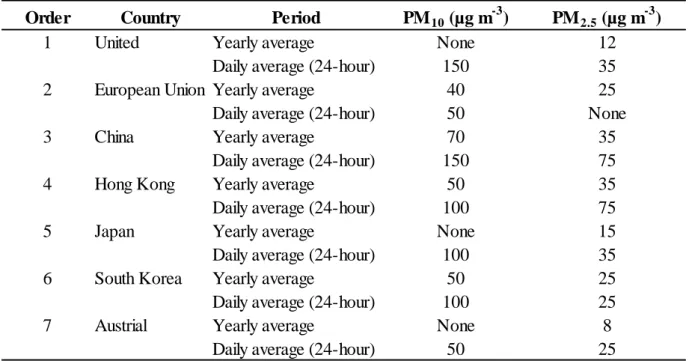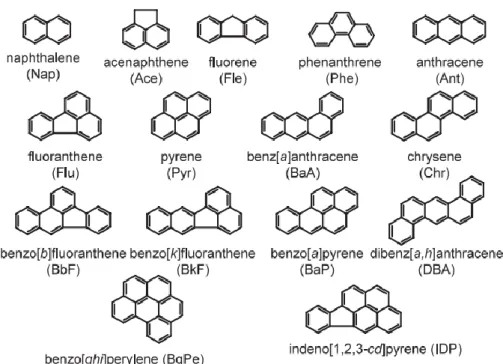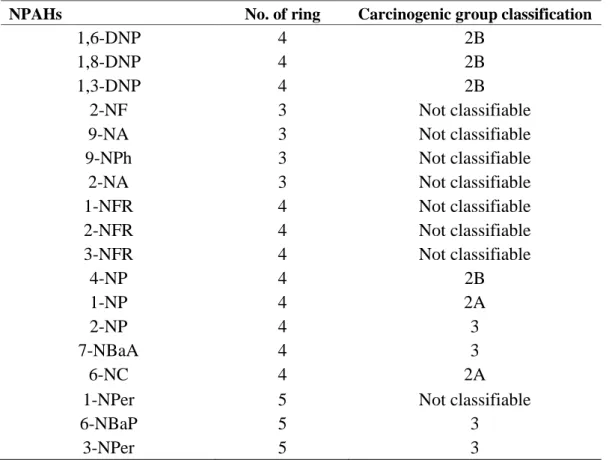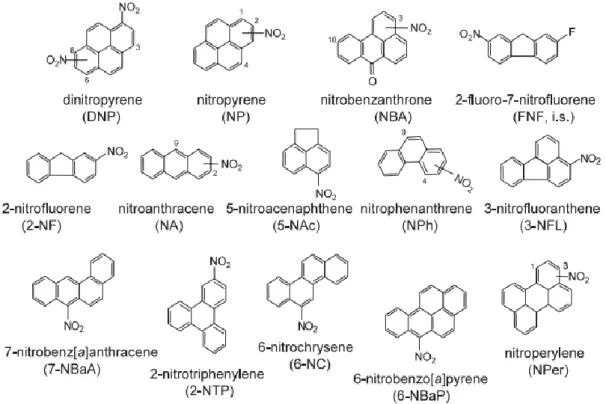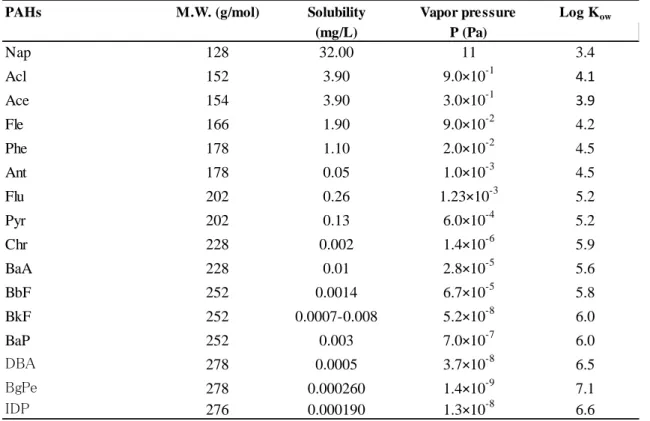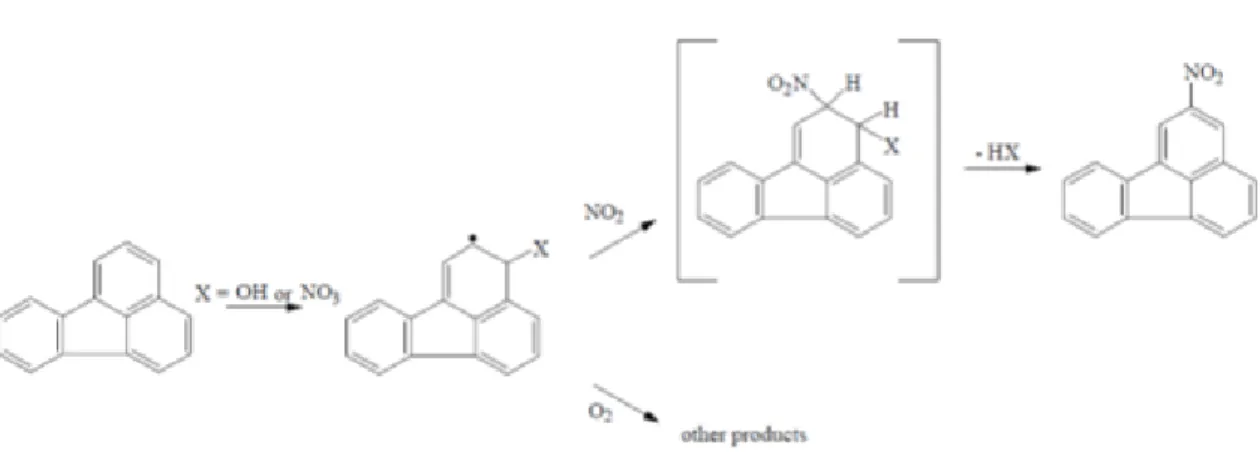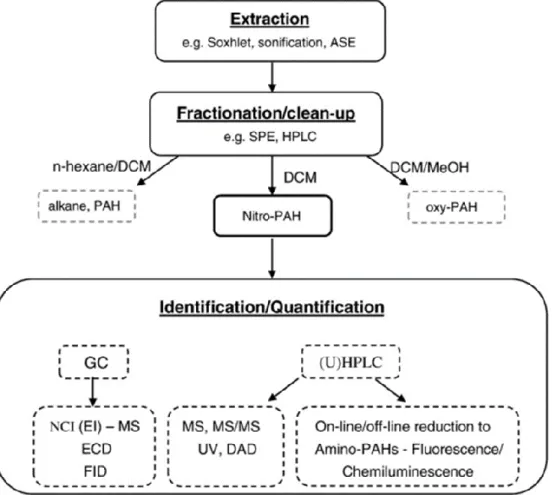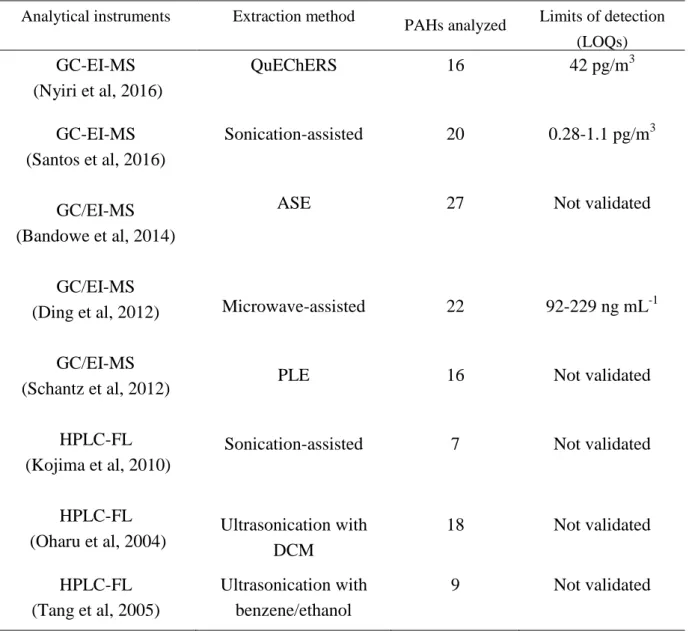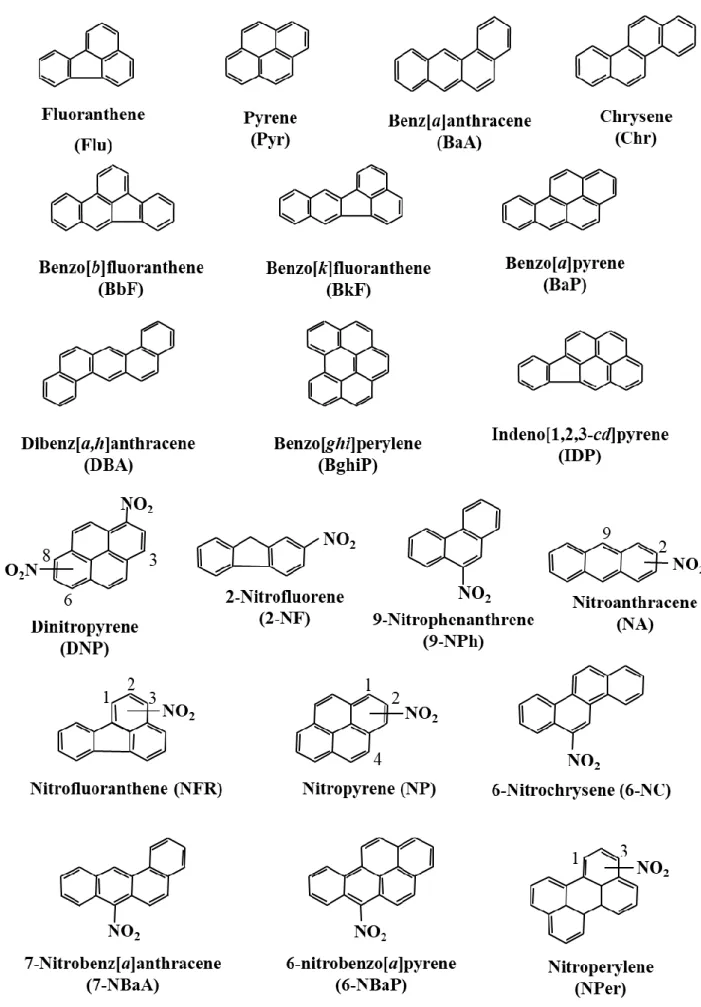Development of an HPLC‑fluorescence method for polycyclic aromatic hydrocarbons and their
nitro‑derivatives in atmospheric particulate matter and its application
著者 ブーングラ ヤオワタット
著者別表示 Yaowatat Boongla journal or
publication title
博士論文本文Full 学位授与番号 13301甲第4605号
学位名 博士(学術)
学位授与年月日 2017‑09‑26
URL http://doi.org/10.24517/00049713
Creative Commons : 表示 ‑ 非営利 ‑ 改変禁止 http://creativecommons.org/licenses/by‑nc‑nd/3.0/deed.ja
i
Dissertation
Development of an HPLC-fluorescence method for polycyclic aromatic hydrocarbons and their nitro-derivatives in
atmospheric particulate matter and its application
大気粒子中の多環芳香族炭化水素及びそのニトロ誘導体の測 定のための蛍光 HPLC法の開発とその応用
Graduate School of Medical Sciences Kanazawa University
Division: Pharmaceutical Science Laboratory: Hygienic Chemistry
School registration No.: 1429012016 Name: Yaowatat Boongla
Primary Supervisor name: Akira Toriba
ii
Dissertation Summary
My dissertation focuses on development of an analytical method for polycyclic aromatic hydrocarbons (PAHs) and their nitro-derivatives (NPAHs) in atmospheric particulate matter (PM).
Analytical methods for PAHs and NPAHs in the PM samples have been widely studied because of their carcinogenicity and mutagenicity. PAHs and NPAHs are mostly determined by gas chromatography (GC) and high-performance liquid chromatography (HPLC). In the reported GC methods using mass spectrometry (MS), PAHs and NPAHs are detected with electron impact ionization (EI) and negative ion chemical ionization (NICI) modes, respectively. GC-MS methods have high sensitivity and selectivity, but have limitations in the separation of several PAHs and difficulty in detecting PAHs with NICI mode. On the other hand, HPLC methods with chemiluminescence detection (HPLC-CL) have been successfully used for NPAH analysis. However, the CL system is complicated by the extra equipment needed for post-column CL reagents, which consume an especially large amount of acetonitrile. Furthermore, the CL detection cannot be applied to PAH analysis because their fluorescence characteristics are inadequate for the CL detection. To overcome the disadvantages of the CL methods, HPLC methods with fluorescence detection (HPLC- FL) are preferable for the analysis of PAHs and NPAHs. The facts motivated me to develop an HPLC-FL method for simultaneous determination of PAHs and NPAHs in atmospheric PM.
My dissertation consists of two steps: (1) Development of an HPLC-FL method for PAHs and NPAHs; (2) Application of the developed method to atmospheric PM samples. The first step was the development of an HPLC-FL method for simultaneously analyzing 10 PAHs and 18 NPAHs. The two-dimensional HPLC system consists of an on-line clean-up and reduction for NPAHs in the 1st dimension, and separation of the PAHs and the reduced NPAHs and their FL detection in the 2nd dimension after column-switching. To identify an ideal clean-up column for removing sample matrix that may interfere with detection of the analytes, the characteristics of 8 reversed-phase columns were evaluated. The nitrophenylethyl (NPE)-bonded silica column was selected because of its shorter elution band and larger retention factors of the analytes due to strong dipole-dipole interactions. After column switching, the amino-substituted PAHs (reduced NPAHs), PAHs and deuterated internal standards were successfully separated on polymeric octadecyl-bonded silica (ODS) columns and by dual-channel detection within 120 min including the 1st dimension. The analytical time for NPAHs was reduced by half compared to the HPLC-CL method and was followed by PAH analysis. The two-channel program was set based on optimal excitation and emission wavelengths of the analytes. Remarkably, 6-nitrochrysene and 7-nitrobenz[a]anthracene were separated by their specific excitation and emission wavelengths, not by the separation columns as they had identical retention times. The signal arising from one analyte was not detected on the other channel. These results suggest that the proposed HPLC-FL system is suitable for the identification of all target compounds. The limits of detection were 0.1-9.2 pg per injection for PAHs and 0.1-140 pg per injection for NPAHs. The second step was the application of the developed method to crude extracts of fine particulate matter (PM2.5) samples and the standard reference material of urban dust (SRM1649b). The extraction procedure of PAHs and NPAHs in PM samples involved ultrasonic extraction with dichloromethane, evaporation and redissolving steps, and then the crude extract was directly injected to the HPLC-FL system. The analytical precision and accuracy were satisfactory for the simultaneous determination of all PAHs and NPAHs in the PM2.5
samples and the observed concentrations of them in SRM1649b samples were similar to those in previous reports. Thus, the method developed herein has the potential to become a standard HPLC- based method, especially for NPAHs.
iii Table of contents
Dissertation summary.………...i
List of Table………...iv
List of Figure………...v
List Abbreviation ………...vi
Chapter 1: Introduction………...1
1.1 Background information………..1
1.2 Atmospheric particulate………...2
1.3 Toxicity of PAHs and NPAHs……….3
1.4 Source, characteristic and properties of PAHs……….6
1.5 Source, characteristic and properties of NPAHs………..8
1.6 Analysis of PAHs and NPAHs in atmospheric particulate matters………...11
1.7 Motivation and purpose of this dissertation………...17
Chapter 2: Development of a HPLC method for polycyclic aromatic hydrocarbon and their nitro in atmospheric particulate matter……….20
2.1 Introduction………...20
2.2 Materials and methods………...22
2.2.1 Chemical and reagent……….……….22
2.2.2 Column evaluation for clean-up column...………..22
2.2.3 HPLC system condition ……….24
2.2.4 Particulate matter samples and extraction procedure..………….………...27
2.2.5 Calibration, sensitivity, accuracy and precision……….………...27
2.3 Results and discussion………....27
2.3.1 Column evaluation for the clean-up column………...27
2.3.2 Separation and detection of analytes in the 2nd dimension………..…………...30
2.3.3 Limit of detection (LOD), limit of quantification (LOQ) and calibration curve……....34
2.3.4 Accuracy and precision………...34
2.3.5 Quantitative determination of atmospheric sample……….……...38
2.4 Conclusions………....40 References
Acknowledgement
iv
List of tables
1.1 PM regulation guideline set by various governments……….…. ...2
1.2 Sixteen priority PAHs were classified by IARC, compared to classification by the US EPA and DHHS………....4
1.3 Carcinogenic classification of typical NPAH by IARC……….…..5
1.4 Physical-chemical characteristic of some PAHs………..7
1.5 Physical-chemical characteristic of some NPAHs……….10
1.6 Analytical performance of previous method PAHs………...14
1.7 Analytical performance of previous method NPAHs………....17
2.1 Major interaction of the examined columns………...24
2.2 Gradient condition for the separation of amino derivatives of NPAHs……….25
2.3 Retention time, excitation and emission wavelengths, channel for the analytes……….…..26
2.4 Capacity factor (k values) of PAHs and NPAHs in the examined columns……….…….29
2.5 Limit of detection (LOD), limit of quantification (LOQ) and calibration and NPAHs by Proposed HPLC-FL method……….………..35
2.6 Precision and accuracy in the analyzed results of PAHs (n=4)………...36
2.7 Precision and accuracy in the analyzed results of NPAHs (n=4)………..37
2.8 Comparison of quantified concentrations of PAHs (mg/kg) and NPAHs (µg/kg) SRM1649b in this study to literatures………....39
v
List of figures
1.1 Structures of Fluorescent PAHs in USEPA List………..4
1.2 Structures of typical NPAHs in atmospheric………...6
1.3 Gas phase reaction of 2-nitrofluoranthane………...9
1.4 Schematic for three main steps for determination of PAHs and nitro-PAHs………...11
1.5 Structure of the 10 PAHs and 18 NPAHs analyzed in this study………..19
2.1 Schematic diagram of the simple HPLC-FL method for column evaluation………...23
2.2 Schematic diagram of the developed HPLC-FL method………...25
2.3 Representative standard chromatograms of PAHs and NPAHs measured by the developed HPLC-FL method………...31
2.4 Representative standard chromatograms of resulting from the crude extract of the spiked PM2.5 samples………...32
2.5 Representative chromatograms of resulting from the crude extract of SRM 1649b……….33
vi
List of abbreviation
Ant Anthracene
BaA Benz[a]anthracene
BaP Benzo[a]pyrene
BbF Benzo[b]fluoranthene BghiPe Benzo[ghi]perylene BkF Benzo[k]fluoranthene
Chr Chrysene
CL Chemiluminescence
CO2 Carbon dioxide
DBA Dibenz[a,h]anthracene DCM Dichloromethane
DHHS The Department of Health and Human Services DMSO Dimethyl sulfoxide
DNP Dinitropyrene
EPA Environmental Protection Agency
FL Fluorescence
Flu Fluoranthene
GC Gas Chromatography
GC-MS Gas Chromatography-mass spectrometry
GC-EI-MS Gas Chromatography-mass spectrometry with electron ionization
GC-NICI-MS Gas Chromatography-mass spectrometry with negative-ion chemical ionization HPLC High Performance Liquid Chromatography
IARC The International Agency for Research on Cancer IDP Indeno[1,2,3-cd]pyrene
LOD Limit of detection LOQ Limit of quantification
MS Mass Spectrometry
NAAQS National Ambient Air Quality Standards NBaA Nitrobenz[a]anthracene
vii NBaP Nitrobenzo[a]pyrene
NC Nitrochrysene
NFR Nitrofluoranthene
NP Nitropyrene
NPAHs Nitropolycyclic aromatic hydrocarbon NPhe Nitrophenanthrene
NIST National Institute of Standards and Technology PAH Polycyclic aromatic hydrocarbon
PM Particulate matter
PM2.5 Fine particulate matter (Particulate matter less than 2.5 micrometers)
Pyr Pyrene
SD Standard deviation
SRM Standard reference material TSP Total suspended particulate matter
US EPA United States Environmental Protection Agency WHO World Health Organization
1
Chapter 1 Introduction
1.1 Background information
Air pollution become serious issue because exposure of air pollution caused health problem and among policy maker and many researchers are an increasing awareness about their effective. Air pollution contaminated into the indoor or outdoor environment by any chemical, physical or biological agents that modifies the natural characteristics of the atmosphere, residence, vehicles, industrial process and forest fires are common sources of air pollution. Pollutants of major public health concern include particulate matter, carbon monoxide, ozone, nitrogen dioxide sulfur dioxide and lead. Air pollution cause respiratory and other diseases, which can have a fatal impact on human health. The US EPA or United States Environmental Protection Agency has established air quality standard for six common air pollutants to protect public health and environment. These substances have been used as indicators of air quality. High contamination of the air pollutants (poor air quality) can cause health problem to human. For example, its aggravate existing respiratory diseases such as asthma and bronchitis, or increase the risk of respiratory problems. Additionally, air quality is important to protect and prevent the life environment from harmful and unhealthy levels of air pollution, the governments of various countries have adopted policy and regulation to protect the health and wellbeing of humans, ecosystem and animals. Air quality standards have been set as limits on emission and air pollution in various areas in the world.
Particulate matter or PM contains microscopic solids or liquid droplets on the order of micrometers that can be inhaled and cause serious health problems and air pollutants. PM can be classified by the particles size and it is directly linked to their potential for causing health problems.
PM2.5 or fine particles less than 2.5 μm (PM2.5) in diameter pose the greatest health problems because they can get deep into lung, and some may even get into your bloodstream. A long-term exposure to fine particles leads to more serious chronic disorders than ground-level ozone and other air pollutants such as carbon monoxide (CO). PM is a heterogeneous mixture of solid and liquid particles suspended in air, which varies continuously in chemical composition and size fraction depending on time and space. It found that the chemical constituents of PM are diverse and they consist nitrate, sulfates, elemental carbon, organic carbons such as organic compounds (e.g. polycyclic aromatic hydrocarbons (PAHs)) and biological compounds (e.g. endotoxin and cell fragments) and metals (e.g. iron, copper, nickel, zinc, and vanadium). Many researchers have studied and tried to explain PM adverse effects including oxidative damage, enhancement of the inflammatory response, cytotoxicity and mutagenicity that ultimately lead to chronic diseases, increased morbidity, and mortality. The mechanisms involved in these toxic effects and the contribution of constituents of PM such as PAHs to overall toxicity of PM is still poorly understood. Moreover, PM have been well- studied for source distribution, formation, fate, behavior, size fractionation, analytical method and environmental monitoring and it is well known that the status of PM pollution is highly significant in some Asian countries.
2
1.2 Atmospheric particulate matter (PM)
Atmospheric particulate matter (PM) can be emitted by a large variety of sources which influence its chemical composition, physical properties (size, surface area and density) and size distribution. In general, Atmospheric PM sources are classified by two main sources as primary or secondary formations in accordance with its formation mechanism. PM directly emitted into the atmosphere from primary natural and anthropogenic sources. The most noteworthy anthropogenic sources are incomplete combustion processes of fossil fuels and biomass (Grudzinski, 2007). On the other hand, secondary sources of particles are formed after chemical transformation of their gaseous precursors (Perrino, 2010).
Atmospheric PM is classified by particle size (aerodynamic diameter). Several metrics for PM have been used. PM10 and PM2.5 is PM with an aerodynamic diameter of less than 10 and 2.5 μm, which have serious problems because easily to get deep into human lung, respectively. The PM2.5 fraction is also called “fine particles”, and particles between 2.5 and 10 μm are currently named
“coarse particles”. Air Quality Standards have been set in the world such as the United States, European union (EU), China, Hong Kong, Japan, South Korean and Australia for considered to be a basic requirement of human health, environment. The summary of regulations for PM in the world were listed in Table 1.1 (Kim et al., 2015). Numerous researchers in Asia, US and Europe have reported effects of PM level to human health. PM are related to respiratory symptoms, chronic bronchitis, cardiovascular diseases, premature mortality (Kappos et al.,2004; Englert et al.,2004;
Samoli et al., 2008;Polichetti et al.,2009; Cheng et al.,2013).
Table 1.1 Atmospheric particulate matter (PM) regulation guideline set by various governments Order Country Period PM10 (µg m-3) PM2.5 (µg m-3)
1 United Yearly average None 12
Daily average (24-hour) 150 35
2 European Union Yearly average 40 25
Daily average (24-hour) 50 None
3 China Yearly average 70 35
Daily average (24-hour) 150 75
4 Hong Kong Yearly average 50 35
Daily average (24-hour) 100 75
5 Japan Yearly average None 15
Daily average (24-hour) 100 35
6 South Korea Yearly average 50 25
Daily average (24-hour) 100 25
7 Austrial Yearly average None 8
Daily average (24-hour) 50 25
3
1.3 Toxicity of PAHs and NPAHs
One of the typical hazardous organic compounds in PM is polycyclic aromatic hydrocarbon (PAHs) and their nitro-derivatives as nitropolycyclic aromatic hydrocarbon (NPAHs). They are of great concern due to their carcinogenic and/or mutagenic activities to human (Ames et al., 1975). In general, atmospheric PAHs and NPAHs are primarily generated from the incomplete combustion of organic matter. Several NPAHs are appeared by the reaction of parent PAHs with nitrate radicals or NO3 in the nighttime and the reaction with hydroxyl radicals or OH in the presence of NOx in daytime (Wu et al., 2012). PAHs and NPAHs having strong carcinogenic and/or mutagenic activities are mainly associated with PM and especially some NPAHs have specific concern because the shown strongest direct-acting carcinogenicity and/or mutagenicity compared to their parent PAHs (Hayakawa et al., 1995).
Polycyclic aromatic hydrocarbon (PAHs) are a large group of hazardous organic compounds with at least two or more fused aromatic (benzene) rings. Low molecular weight (2 and 3 rings) of PAHs in the atmosphere are predominantly existed in vapor phase, whereas high molecular weight (5 ring or more) of PAHs are largely bound to atmospheric PM. Intermediate molecular weight (4 rings) of PAHs are partitioned between the vapor and particulate phases, depending on the atmospheric temperature. PM-bound PAHs has considered to be serious hazardous to human health (Choi et al.
2010). Typical PAHs observed in atmosphere are shown their structure and abbreviations in Fig. 1.1.
Moreover, the Department of Health and Human Services (DHHS) has determined that benz[a]anthracene (BaA), benzo[b]fluoranthene, benzo[j]fluoranthene, benzo[k]fluoranthene, benzo[a]pyrene, dibenz[a,h]anthracene, and indeno[1,2,3-c,d]pyrene are identified as animal carcinogens. The International Agency for Research on Cancer (IARC) has determined as follows;
BaP (Group 1, carcinogenic to human); DBA (Group 2A, probably carcinogenic to humans); BbF, BkF, IDP (Group 2B, possibly carcinogenic to humans). EPA has determined that BaA, BaP, benzo[b]fluoranthene, BkF, Chr, DBA, and IDP are probable human carcinogens and that Ace, Ant, BgPe, Fle, Flu, phe, and Pyr are not classifiable as to human carcinogenicity. The DHHS, IARC, or EPA are identified Ace has not been classified for carcinogenic effects (Mumtaz et al. 1995). The carcinogenic classification of 16 priority PAHs by the IARC, the US EPA and the DHHS shows in Table 1.2.
Additionally, In European found BaP is associated with fine particulate matter and has the highest carcinogenic potency. It has been recognized as the most toxic PAHs and standard values have been defined in several countries to protect human health.The European Commission has fixed a target value of 1 ng m−3 for the annual average concentration of BaP in ambient air (European Environment Agency, 2015). The concentrations of PAHs in ambient air including BaP are of increasing concern in Europe due to the BaP levels have been relatively higher concentrations than the target values. During the year of 2011-2013, the EU was found to be exposed to BaP about 25–
29% of the urban population over the above mention target values.Considering the WHO reference level of 0.12 ng m−3,85-91% of the urban populations in the EU are being exposed to BaP at the concentration higher than the reference level. This reference level was estimated by assuming the WHO unit risk for lung cancer through exposure to PAH mixtures and an acceptable risk of additional lifetime risk of approximately 1×10-6 (Hellen et al., 2017). Zhu et al., (2011) measured BaP concentrations and found that the average ambient concentration of BaP in an urban community and Village of Waterfront South (WFS) are contaminated with various sources of air toxicity in
4
Camden, New Jersey (0.36 ng/m3) were higher concentrations than the standard value (0.25 ng/m3)in United state.
Fig. 1.1 Structures and abbreviations of PAHs classified as priority pollutants by USEPA (Hayakawa, 2009)
Table 1.2 Carcinogenic classification of 16 priority PAHs classified by IARC, US EPA and DHHS.
IARC classification; Group 1 (carcinogenic), 2A (probably carcinogenic), 2B (possible carcinogenic), 3 (not classifiable)
PAHs No. of ring US EPA IARC DHSS
Nap 2 2B
Acl 3 Not classifiable
Ace 3 3
Fle 3 Not classifiable 3
Phe 3 Not classifiable 3
Ant 3 Not classifiable 3
Flu 4 Not classifiable 3
Pyr 4 Not classifiable 3
Chr 4 Probably carcinogen 2B
BaA 4 Probably carcinogen 2B Animal carcinogen
BbF 5 Probably carcinogen 2B Animal carcinogen
BkF 5 Probably carcinogen 2B
BaP 5 Probably carcinogen 1 Animal carcinogen
DBA 5 Probably carcinogen 2A Animal carcinogen
BgPe 6 Not classifiable 3
IDP 6 Probably carcinogen 2B Animal carcinogen
5
Recently, NPAHs can be found in trace amounts in most of environmental compartments. In recent years, increasing attention has been concerned on NPAHs because of their higher mutagenicity (2 × 105 times) or carcinogenicity (10 times) than their parent-PAHs. (Zhang et., al 2014). NPAHs are derivative of PAHs and they are a class of aromatic compounds with containing at least one nitro-functional group on the aromatic ring and Fig. 1.2. shown structures and abbreviations of typical NPAHs observed in atmosphere. NPAHs can either be directly emitted from combustion sources such as diesel and gasoline engines and formed in the atmosphere via their parent PAHs reactions with OH or NO3 radical. (Pitts, 1977). Meanwhile, the IARC has classified 1,3- 1,6- and 1,8-dinitropyrene (1,3-,16- and 1,8-DNPs) as Group 2B and 1-nitropyrene (1-NP) as Group 2A (IARC, 2013). Carcinogenic classification of typical NPAHs by IARC shows in table 1.3. The widely accepted short-term assay, Ames test is an indicator for DNA damage leading to gene mutation which could be linked to cancer. Parent PAHs are indirect-acting mutagens, requiring metabolic activation to convert them into active forms (Jariyasopit, 2013). Most NPAHs are direct- acting mutagens which are independent of metabolic activation, with an exception of 6- nitrobenz[a]pyrene and 1-nitrocoronene (IPC 2003). Some NPAHs were found to be more toxic than their parent PAHs. For example, DNPs were found to be very powerful direct-acting mutagens, greatly exceeding that of pyrene (Hayakawa et al., 1995; Jariyasopit, 2013). Therefore, extremely low concentrations of some NPAHs in the environment, compared to PAHs, would show a large contribution to total mutagenicity. Although the mutagenicity of DNPs were greater than that of BaP, the lack of their carcinogenicity studies on humans resulted in DNPs being classified as Group 2B,
“possibly carcinogenic to humans” by IARC.
Table 1.3 Carcinogenic classification of typical NPAHs by IARC
NPAHs No. of ring Carcinogenic group classification
1,6-DNP 4 2B
1,8-DNP 4 2B
1,3-DNP 4 2B
2-NF 3 Not classifiable
9-NA 3 Not classifiable
9-NPh 3 Not classifiable
2-NA 3 Not classifiable
1-NFR 4 Not classifiable
2-NFR 4 Not classifiable
3-NFR 4 Not classifiable
4-NP 4 2B
1-NP 4 2A
2-NP 4 3
7-NBaA 4 3
6-NC 4 2A
1-NPer 5 Not classifiable
6-NBaP 5 3
3-NPer 5 3
IARC classification; Group 1 (carcinogenic to human), 2A (probably carcinogenic to humans), 2B (possible carcinogenic to humans), 3 (not classifiable as to its carcinogenicity to humans), 4 (probably not carcinogenic to humans)
6
Fig. 1.2 Structures and abbreviations of typical NPAHs observed in atmospheric (Hayakawa, 2009)
1.4 Source, formation and behavior of PAHs
PAHs are emitted to the atmosphere primarily from the incomplete combustion of organic materials. The combustion sources can be either natural or anthrapogenic. The natural sources are such as from volcanoes and forest fires, whereas the anthropogenic sources are vehicle exhaust, agricultural fires, power plants, coke plants, steel plants, foundries and industrial sources (Golomb et al., 2001; Halsall et al., 2001; Garban et al., 2002; Shafy et al., 2015). PAHs are ubiquitously distributed in atmosphere due to their widespread sources and behavior such as long-range transportation. PAHs consist of carbon and hydrogen atoms grouped and are a large group of chemicals at least 2 to 7 fused aromatic rings (Kim et al., 2013). However, PAHs can be decomposed through photochemical reactions in the atmosphere under strong ultraviolet light and/or sunlight.
Additionally, PAHs can react with hydroxyl radicals, ozone, sulfur oxide, nitrogen, nitric and sulfuric acids which affect the environmental fate of PAHs (Lee and Vu, 2010).
The physicochemical properties of the PAHs have a large effect on their environmental behavior.
Some PAHs are semivolatile substances and frequently existed both in the vapor and particle phases, depending on the vapor pressure of each PAH and atmospheric conditions (Wingfors et al., 2001;
Basheer et al., 2003). PAHs can be divided into two categories which are low molecular weight PAHs (LMW) and the high molecular weight of PAHs (HMW). PAHs are hydrophobic and lipophilic compounds which increase as the number of rings increases. Physicochemical properties of 16 PAHs are shown in Table 1.4. The PAHs has been classified as priority pollutants based on their toxicity by the US EPA (US EPA 1982).
PAHs tend to be observed in higher concentrations in urban environments than those in rural environments because most PAHs sources are located in the local area. PAH concentrations in the gas phase increase in summer or in tropical regions, whereas particulate phase PAHs are dominant
7
during in winter or in cold region throughout the year (Lai et al., 2011; Mohanraj et a., 2012).
Furthermore, when industrial emissions are a major source of PAHs, their concentrations show little seasonal variations because the emission is constant throughout the year (Kim et al. 2013). However, in most urban, residential and rural areas where the local sources are related to residential and commercial heating, they show significant seasonality during the year (e.g. relative enhancement during the cold winter). This effect is particularly pronounced when the fuels used for heating indicating high PAH emission factors. A clear example was found in Northern Ireland, UK where solid fuels such as coal and wood are still commonly burnt for heating (Lisowska et al. 2005). The average BaP concentration in December to January and June to August were 3.0 ng/m3 and 0.19 ng/m3, respectively. Moreover, PAH adsorption onto particle phase depends on humidity (Zhang et al., 2009) and the type of suspended particulates such as soot, dust, fly-ash, pyrogenic metal oxide pollens, etc (Li et al., 2011).
The background level of some representative PAHs was reported values to be 0.02 to 1.2 ng/m3 in rural areas and 0.15 to 19.3 ng/m3 in urban area (Huertero et al., 2011), and urban background in 120 US cities fluctuated between 0.15-19.3 ng/m3 (ATSDR, 1995). Legzdins et al. (1994) was studied about PAHs and determined that BgPe was the highest individual PAH concentrations among PAHs measured in Hamilton, Ontario and New York City. The specific values, 4.3 ng/m3 in Hamilton and 4.05 ng/m3 in New York City, supported the notion that PAH levels of urban ambient air show ageneral pattern when free of point source contributions. A worldwide study of 60 towns in the mid-1970’s determined BaP concentrations in US and European ambient air. The levels in the US and Europe are approximately 1 ng/m3 and a range of 1-20 ng/m3, respectively. (Menichini, 1992).
However, the range of BaP in Europe was significantly improved in the 1990’s (EU, 2001). Rural background levels varied between 0.1 and 1 ng/m3, and urban baselines ranged from 0.5 to 3 ng/m3. Nonetheless, the EU (2001) reported 30 ng/m3 as the commonly accepted background concentration around industrial areas.
Table 1.4 Physical-chemical characteristics of some PAHs
PAHs M.W. (g/mol) Solubility Vapor pressure Log Kow
(mg/L) P (Pa)
Nap 128 32.00 11 3.4
Acl 152 3.90 9.0×10-1 4.1
Ace 154 3.90 3.0×10-1 3.9
Fle 166 1.90 9.0×10-2 4.2
Phe 178 1.10 2.0×10-2 4.5
Ant 178 0.05 1.0×10-3 4.5
Flu 202 0.26 1.23×10-3 5.2
Pyr 202 0.13 6.0×10-4 5.2
Chr 228 0.002 1.4×10-6 5.9
BaA 228 0.01 2.8×10-5 5.6
BbF 252 0.0014 6.7×10-5 5.8
BkF 252 0.0007-0.008 5.2×10-8 6.0
BaP 252 0.003 7.0×10-7 6.0
DBA 278 0.0005 3.7×10-8 6.5
BgPe 278 0.000260 1.4×10-9 7.1
IDP 276 0.000190 1.3×10-8 6.6
8
1.5 Source, formation and behavior of NPAHs
NPAHs are derivatives of PAHs containing at least one nitro-functional group on the aromatic benzene ring of a PAH (Bandowe et al., 2017). As mentioned above, NPAHs are mainly generated by incomplete combustions and also formed by atmospheric reactions of gas- and particulate-phase PAHs with oxidants, (Schuetzle et al., 1989; Araki et al., 2009). The physico-chemical properties of NPAHs which commonly found in the environment are affected by the molecular weight (MW) and number of nitro-groups (Table 1.5). The physico-chemical properties of NPAHs listed on Table 1.5 were determined by different experimental methods, and modeling approaches, which also lead to inconsistent trends and makes the datasets not completely comparable (Yaffe et al., 2001; IPCS, 2003). With increasing MW, NPAHs have higher melting points (Mp), octanol-water partition coefficients (KOW) octanol-air partition coefficients (KOA), organic carbon-water partition coefficient (KOC) and particle-gas partition coefficients (KP), but lower vapor pressures (Vp), water solubility (S) and Henry constants (H). These properties drive the fate, transport, partition, and transfer of NPAHs within and between environmental compartments (gas phase, particle phase, water-dissolved phase, water suspended particles, sediments, biota and soil) and their (eco)toxicological effects.
NPAHs have higher MW, KOA, KP, and lower Vp, S, KOW, KOC and H than their related PAHs.
Generally, a nitro-PAH derived from single NO2-functional group substitution on a PAH reduces the Vp and S by 3 and 1 order of magnitude, respectively (Yaffe et al.,2001). The KOW cangenerally decrease (by 25–80%) with nitro-group substitution on PAHs (IPCS, 2003; Yaffe et al., 2001). The presence of nitro-group leads to a decrease in S compared to their related PAHs as shown in Table 1.5, which can be explained by the higher MW of nitro-PAHs. The decreases in KOW, KOC and H (compared to related PAHs) are consistent with the presence of the more polar nitro-groups.
However, the higher KOA of nitro-PAHs compared to their related PAHs, indicates that the introduction of nitro-groups leads to higher partition into a more hydrophobic octanol phase. The effects of the presence of nitro-groups on a PAH on the physical and partition properties is complicated, driven by several factors not necessarily related to the known relationships between polarity of molecules, aqueous solubility and partition into hydrophobic media like octanol (Bandow et al., 2017). NPAHs with 2 aromatic rings were detected in the vapor phase (gas-partition), and three rings NPAHs were found in both gas and particle phase in the atmosphere. On the other hand, NPAHs with 4 or higher ring were mainly distributed in particle phase (Dimashki et al., 2000).
NPAHs have been primarily detected in airborne PM, and their concentrations in urban areas are higher than those in suburban areas. However, their concentrations range from pg/m-3g to ng/m-3 and are significantly lower than their parent PAH concentrations. (Jariyasopit, 2008; Garcia et al., 2014).
NPAHs distributed in the particulate phase are primarily dominated by the NPAHs formed through atmospheric gas-phase reactions (Jariyasopit 2008). A substantial percentage of NPAHs containing 2- 4 benzene rings in the atmosphere are formed from gas-phase reactions of parent PAHs with atmospheric oxidants (OH, O3, NOx; Dimashki et al., 2000; Atkinson and Arey, 1994; Arey et al., 1986). These radicals are unstable during daytime due to the fast photolysis of NO3. After sunset the concentration rises to an average of 5 × 108 molecules/cm3 (Atkinson and Arey, 1994). Both nitronaphthalene isomers, which are formed in similar yields, are not the main products of the OH- initiated reaction, but hydroxynaphthalene and 1,4-napthoquinone. NO3-initiated reactions lead to 16% of 1-nitronaphthalene and 7% of 2-nitronaphthalene (Vione et al., 2004; Atkinson et al., 1987).
The radical initiated reactions are postulated to proceed through initial addition of either the NO3
radical or the OH radical to the position with the highest electron density in the PAH molecule (e.g.
the one position from pyrene and the three positions of fluoranthene) as seen in Fig. 1.3. This followed by the addition of NO2 at the ortho-position and subsequent loss of water or nitric acid to form 2-nitrofluoranthene (2-NFR) or 2-nitropyrene (Arey et al., 1986). 2-NFR and 2-NP have not been identified in other combustion products or diesel exhaust. Moreover, gas phase reaction in the laboratory studies have reported NPAH production via hetorogeneous reaction (Pitts et al., 1985;
9
Kamens et al. 1990). Generally, 2-nitrofluoranthene showed the most abundant NPAH in ambient atmosphere (Zimmermann et al., 2013). NPAH isomers formed in the atmosphere can be distinguished from those formed from chemical reactions in combustion processes, in view of their formation mechanisms. For example, imperfect combustion processes that result in the formation of NPAH isomers are formed via electrophilic nitration, such as 3-NFR and 1-NP from the most abundant PAHs with four rings (Pyr and Flt) (Gracia et al., 2014). Especially, 3-NFR and 1-NP are not easily formed through gas phase reaction, and almost of them exist exclusively in particulate phase.
NPAHs has been interested studies by several researchers because of their behavior in the environment and NPAHs are shown higher carcinogenic and mutagenic properties of certain compounds compared to their parent PAHs (Bandowe et al., 2017). NPAHs also showed strong exhibit direct-acting mutagenic potency in a microbial bioassays and mutation on assay based on human cells (Jariyasopit, 2008). Significant portion of mutagenicity of the extract of atmospheric samples have attributed to NPAHs such as 1,3-, 1,6- and 1,8-DNPs, 1,3,6-trinitropyrene, 3,9- dinitrofluoranthene and 3,6-dinitrobenzo[e]pyrene (Hasei et al., 2006, 2009; Watanabe and Hirayama, 2001; Watanabe et al., 2005, 2008; Wang et al., 2011; Umbuzeiro et al., 2008).The toxic properties of NPAHs have been assessed and assigned toxicity equivalency factors (TEFs) much higher than their related PAHs (IARC,1989, 2012; Collins et al., 1998).
Fig. 1.3 Gas phase reaction of 2-nitrofluoranthene (2-NFR)
10 Table 1.5 Physical-chemical characteristics of typical NPAHs
NPAHs M.W. (g/mol) Melting Solubility Vapor pressure Henry constant Log Log Log Kp point (°C) (mg/L,25°C) (Pa,25°C) (Pa m3/mol) Log KOW KOA KOC (m3/µg)
1,6-DNP 292.25 204.76 5.4×10-2 1.21×10-7 6.57×10-4 4.57 12.85 3.89 1.73
1,8-DNP 292.25 204.76 5.4×10-2 1.21×10-7 6.57×10-4 4.57 12.85 3.89 1.73
1,3-DNP 292.25 204.76 5.4×10-2 1.21×10-7 6.57×10-4 4.57 12.85 3.89 1.73
2-NF 211.22 157.00 0.22 5.9×10-4 7.78×10-2 3.37 7.94 3.01 2.13×10-5
9-NA 223.23 146.00 0.115 1.60×10-4 4.12×10-1 4.78 9.86 3.79 1.78×10-3
9-NPh 223.23 141.62 0.292 1.79×10-4 1.38×10-1 4.16 9.24 3.44 4.28×10-4
2-NA NA NA NA NA NA NA NA NA NA
1-NFR NA NA NA NA NA NA NA NA NA
2-NFR NA NA NA NA NA NA NA NA NA
3-NFR 247.26 170.56 1.95×10-2 7.36×10-6 2.68×10-2 4.75 10.62 3.77 1.03×10-2
4-NP 247.26 170.56 6.79×10-2 5.52×10-8 2.68×10-2 4.75 10.93 3.77 1.03×10-2
1-NP 247.26 155.00 1.18×10-2 1.11×10-5 7.39×10-2 5.06 10.93 3.94 2.11×10-2
2-NP 247.26 170.56 6.79×10-2 7.36×10-6 2.68×10-2 4.75 10.93 3.77 1.03×10-2
7-NBaA NA NA NA NA NA NA NA NA NA
6-NC 273 187 1.53×10-2 1.01×10-6 1.82×10-2 5.34 11.43 4.1 6.64×10-2
1-NPer NA NA NA NA NA NA NA NA NA
6-NBaP 297.32 211.87 3.49×10-3 4.14×10-8 3.52×10-3 5.9 12.81 4.42 1.6
3-NPer NA NA NA NA NA NA NA NA NA
11
1.6 Analysis of PAHs and NPAHs in atmospheric pollutant
The determination of PAHs and NPAHs in airborne PM are carried out with similar steps. There are three main steps; (1) sample collection and extraction steps, (2) the clean-up and fractionation steps, (3) The identification and quantification of the target compounds. (Bin et al., 2007; Bandown et al., 2017). Fig 1.4 shows the three main steps for the determination of PAHs and NPAHs. Most PAHs are found in high concentrations more than NPAHs in the atmosphere. In the atmosphere, most PAHs that have 2-4 rings (Low molecular weights, LMW) exist mainly as gases, while PAHs more than 5 rings (High molecular weight, HMW) exist in the particulate phase (Araki et al 2009;
Park et al. 2002; Ravindra et al. 2006; Chang et al. 2006). In addition, most NPAHs in the atmosphere exist in gas phase or in particulate phase. Most 4 and 5 ring NPAHs exist in the particulate phase (Bamford et al. 2003). The concentration of PAHs in all sample matrices like air, water and soil is generally higher than that of NPAHs (Yaffe et al 2001).
Fig 1.4 Scheme for three main steps determination of PAHs and nitro-PAHs
PAHs and PAHs have been determined in different phases of air samples (vapor phase, total suspended particles (TSP), specific size fractions (PM1, PM2.5 and PM10) or size segregated fractions). The high/low volume air samplers or cascade impactors are often equipped with foams (PUFs) and or quartz fiber filters to collect vapor phase and particulate phase PAHs and NPAHs, respectively. After sample collection, the quartz filters and PUFs are usually wrapped in aluminium foil and stored at -20 °C until analysis (Bin et al., 2007; Bandowe et al., 2017)
12
After sampling, air sample are need to pretreatment because complex environmental matrices and extensive cleanup of the extract prior to analysis. Bin et al. (2007) reviewed sample pretreatment techniques for PAHs in environmental matrix. Most popular solvent used for extraction are acetonitrile, benzene, dichloromethane, toluene, cyclo-hexane and also their mixture are often used as extraction solvent. Solvent extraction such as ultrasonic extraction, supercritical fluid extraction (SFE), microwave-assisted extraction, accelerat-ed/pressurized solvent extraction soxhlet extraction and concentration such as K-D evaporator and rotary evaporator concentration and clean-up with columns (Hafner and Hites, 2005) are three mostly applied pretreatment methods for PAHs samples.
And subcritical water extraction has also been applied as pretreatment of air samples. On the other hand, reviewing of Bandowe et al. (2017) explained additional clean-up is usually required for NPAHs more than PAHs because of the generally lower concentration of NPAHs in environmental samples (compared to PAHs) and their lower sensitivity to detection methods.
For improving the quality of chromatographic signal and signal-to-noise ratio, interfering compounds need to be remove by cleanup steps such as solid phase extraction (SPE, with silica gel, alumina, C18, Florisil), open column chromatography (with silica gel), semi-preparative HPLC and gel permeation chromatography (GPC) have been used. In the SPE or open column technique of clean-up, the concentrated extract (of the first extraction step) is applied onto the column and eluted with solvents with different polarity. Prycek et al. (2007) studied the fractionation efficiency on a silica cartridge depending on different solvent mixtures. Applying 500 μL of the redissolved extract in hexane on 5 g fully activated silica gel, the most effective fractionation procedure determined, was as follows: Fraction 1 (nonpolar compounds like alkanes and cycloalkanes) was eluted by 10 mL of n-hexane and then by 5 mL of n-hexane/DCM 4/1 (v/v), fraction 2 (PAHs and alkyl-PAHs) was eluted 10 mL of n-hexane/DCM 4/1 (v/v), fraction 3 (nitro-PAHs) was eluted by 10 mL of DCM, fraction 4 (oxy-PAHs, alcohols) was eluted by 10 mL of DCM/methanol (MeOH) 1/1 (v/v). Other SPE techniques use aminopropyl columns (Cochran et al., 2012), alumina and silica catridges (Albinet et al., 2006) or columns filled with silica gel (10% deactivated) (Wei et al., 2015a, 2015b).
The fractionations proceed with similar combinations of solvents, starting with nonpolar solvents and ending with highly polar solvents (pentane, hexane, dichloromethane, acetone, methanol) (Wei et al., 2015a, 2015b; Albinet et al., 2014, 2006; Cochran et al., 2012). More automated fractionation techniques (normal-phase semi-preparative HPLC or GPC) have also been applied (Niederer, 1998;
Watanabe et al., 1999; Hasei et al., 2006; Brorström-Lundén et al., 2010; Andrade-Eiroa et al., 2010).
A review by Bin et al. reported that the NPAHs were removed and separated from interfering substances on octadecyl-bonded silica (ODS, 4.6 ×150mm) column as a clean-up column in the switching column technique (Bin et al., 2007). Moreover, Hayakawa and Tang have been many reviewed and reported for analyzing NPAHs were removed complicated substances by using clean- up in switching column technique (Hayakawa et al., 2001,2002, 2009, 2011,2016; Tang et al., 2003,2005, 2014, 2017). Variation method for determination PAHs and NPAHs in atmospheric have been reviewed and studied by several researchers. As earlier stated, the sample pretreatment and analytical methods for PAHs in airborne particulate (PM) are summarized and compared in Table in 1.6, It can be concluded from the table shown GC-MS with EI mode and HPLC-FL detection are the analytical methods mostly used for PAHs. Nyiri et al. has been studied and developed methods for
13
the quantitative determination of PAHs in PM samples. The sample preparation procedure included only a simple and quick sonication-assisted extraction step, clean-up based on addition of water and centrifugation as well as pre-concentration under N2 stream. PM2.5 sampling was performed at the Széna Square, urban site in the center of Budapest, Hungary between June 2010 and May 2013. PM sample was clean-up with water. After spiking with 50 μg/L of of the deuterated standard solutions, GC-MS was used for analysis of the 1PAHs (Nyiri et al. 2016). Santos et al. reported that PM samples were collected at the Lapa Bus terminal underground floor (12°58′S, 38°30′W, 52 m altitude), in Salvador, State of Bahia, Northeastern Brazil during April 27th–May 18th, 2010. PM sample were extracted with sonication and mixtures of acetonitrile (ACN) and dichloromethane (DCM) were used as solvent. No further clean-up and fractionation and 20PAHs were analyzed with GC-MS with EI mode (Santos et al., 2016). Schantz et al. studied on four particulate matters standard reference materials (SRMs) available from the National Institute of Standards and Technology (NIST) were used to evaluate the effect of solvent, number of static cycles and static times, pressure, and temperature when using pressurized liquid extraction (PLE) for the extraction of polycyclic aromatic hydrocarbons (PAHs). The four materials used in the study were SRM 1649b Urban Dust, SRM 1650b Diesel Particulate Matter, SRM 1648a Urban Particulate Matter and SRM 2975 Diesel Particulate Matter (Industrial Forklift). SRM 1649b were separated two methods (1) SRM sample extracted with dichloromethane and (2) with toluene. SRM1650b used toluene, SRM 1648 was extracted with dichloromethane and SRM2975 used two methods, SRM were extracted with only toluene and second with toluene/methanol. Finally, PAHs in SRM samples were analyzed with GC- MS with EI mode (Schantz et al., 2012). 24-h PM2.5 samples were collected every sixth day for 13 months from the atmosphere of a Chinese megacity. PM samples were extracted with dichloromethane as accelerated solvent, The GC/MS EI mode were determined 27PAHs (Bandowe et al., 2014).
Ding et al. were conducted each of seven sampling days, 24 hours. PM2.5 samples were collected using 6 stationaries as following; 2 in the kitchen, 2 in the bedroom adjacent to the kitchen, and 2 outdoors, 1–2 m above the ground and 4 personal air samplers simultaneously. PM2.5 were extracted by using a microwave accelerated reaction system (CEM, Mars Xpress, USA). The extracts were purified using silica/alumina chromatography. 22 target PAHs were analyzed with GC EI-MS (Ding et al., 2012).Airborne particulate matter was collected on a quartz fiber filter (8 × 10 inch2, Pallflex Product, 2500QATUP) using a high-volume air sampler (HV-1000F,Shibata Co., Tokyo, Japan).
Filter samples were cut into small pieces and put in a flask. The samples were then extracted 20 min under ultrasonication method with dichloromethane (DCM) and filtered, the filtrate was evaporated to dryness under a stream of N2. The residue was dissolved in DCM 500 μL and cleaned by solid phase extraction (SPE) with a silica gel solid phase (Discovery SPE DSC-Si Silica, Supelco). The extract solution was evaporated to dryness again, and the residue was re-dissolved in 500 μL of acetonitrile. Sample solution was injected into the HPLC-FLD system (Kojima et al.,2010). Tang et al. studied and determined PAHs in airborne particulates which were collected in winter and summer from 1997 to 2002 in seven cities in the Pan–Japan Sea countries, Shenyang (China), Vladivostok (Russia), Seoul (South Korea), Kitakyushu, Kanazawa, Tokyo and Sapporo (Japan). A piece of each filter of airborne particulates was cut into small pieces in a flask and 9PAHs compound were extracted with ultrasonication twice with benzene/ethanol (3/1), particulates were analyzed by HPLC with fluorescence (Tang et al.,2005). PM in indoor and outdoor were determined PAHs in summer
14
and winter at two industrial cities in Shizuoka, Japan, by Ohura et al. reported that airborne particles were collected and size-fractionated using a sampler that combined a minipump (MP-603 T or MP- Σ300; Sibata Scientific Technology Ltd., Tokyo, Japan) with a three-stage cascade impactor (Tokyo Dylec Corp., Tokyo, Japan); the flow rate for sampling was 3.0 l min−1 . Airborne particles were collected and monitored of fractionated particles in indoor and outdoor air was conducted in the cities of Fuji and Shimizu, two proximate (ca. 30 km) cities in Shizuoka Prefecture. Monitoring of 18 PAHs in particles phase were extracted with DCM by using an ultrasonic, centrifugation at 3000 rpm for 10 min and evaporation under N2. PAHs were analyzed with HPLC-FL detection(Oharu et al., 2004).
Table 1.6 Analytical performance of previous methods for PAHs Analytical instruments Extraction method
PAHs analyzed Limits of detection (LOQs) GC-EI-MS
(Nyiri et al, 2016)
QuEChERS 16 42 pg/m3
GC-EI-MS (Santos et al, 2016)
GC/EI-MS (Bandowe et al, 2014)
GC/EI-MS (Ding et al, 2012)
GC/EI-MS (Schantz et al, 2012)
HPLC-FL (Kojima et al, 2010)
Sonication-assisted
ASE
Microwave-assisted
PLE
Sonication-assisted
20
27
22
16
7
0.28-1.1 pg/m3
Not validated
92-229 ng mL-1
Not validated
Not validated
HPLC-FL
(Oharu et al, 2004) Ultrasonication with DCM
18 Not validated HPLC-FL
(Tang et al, 2005)
Ultrasonication with benzene/ethanol
9 Not validated
The determination of NPAHs have been reviewed by Bandowe et al., NPAHs extracted from airborne particulate matters reports have dealt with NPAH concentrations in air, mostly due to their low concentrations and difficulty in detection. Several methods have been used for analysis of NPAHs in atmospheric environment, such as NPAHs have been analyzed by gas chromatographic
